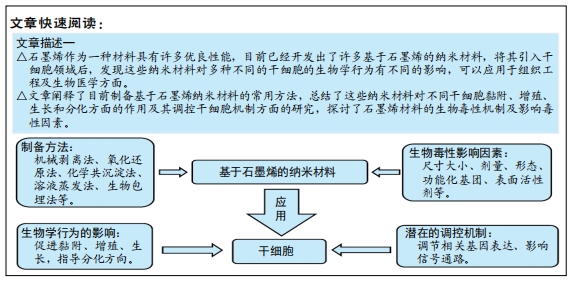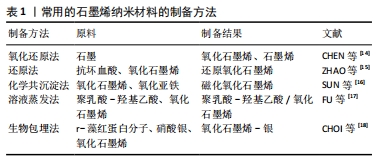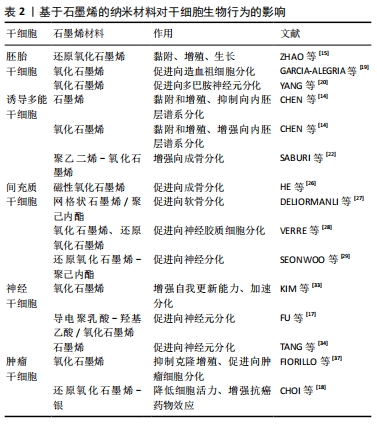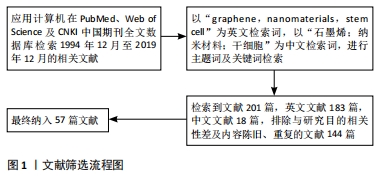[1] HALIM A, LUO Q, JU Y, et al. A Mini Review Focused on the Recent Applications of Graphene Oxide in Stem Cell Growth and Differentiation. Nanomaterials (Basel). 2018;8(9):736.
[2] NOVOSELOV KS, GEIM AK, MOROZOV SV, et al. Electric field effect in atomically thin carbon films. Science. 2004;306(5696):666-669.
[3] SANCHEZ VC, JACHAK A, HURT RH, et al. Biological interactions of graphene-family nanomaterials: an interdisciplinary review. Chem Res Toxicol. 2012;25(1):15-34.
[4] JASTRZĘBSKA AM, KURTYCZ P, OLSZYNA AR. Recent advances in graphene family materials toxicity investigations. J Nanopart Res. 2012;14(12):1320.
[5] YAN L, ZHENG YB, ZHAO F, et al. Chemistry and physics of a single atomic layer: strategies and challenges for functionalization of graphene and graphene-based materials. Chem Soc Rev. 2012;41(1):97-114.
[6] GEETHA BAI R, MUTHOOSAMY K, MANICKAM S, et al. Graphene-based 3D scaffolds in tissue engineering: fabrication, applications, and future scope in liver tissue engineering. Int J Nanomedicine. 2019;14:5753-5783.
[7] 王立宾,祝贺,郝捷,等.干细胞与再生医学研究进展[J].生物工程学报,2015,31(6):871-879.
[8] 周琪,任小波,杨旭,等.面向未来的新一轮医疗技术革命——干细胞与再生医学研究战略性先导科技专项进展[J].中国科学院院刊, 2015,30(2):262-271.
[9] MENAA F, ABDELGHANI A, MENAA B. Graphene nanomaterials as biocompatible and conductive scaffolds for stem cells: impact for tissue engineering and regenerative medicine. Tissue Eng Regen Med. 2015;9(12):1321-1338.
[10] HAN S, SUN J, HE S, et al. The application of graphene-based biomaterials in biomedicine. Am J Transl Res. 2019;11(6):3246-3260.
[11] GUO X, MEI N. Assessment of the toxic potential of graphene family nanomaterials. Food Drug Anal. 2014;22(1):105-115.
[12] ZHAO D, LI Z, LIU L, et al. Progress of Preparation and Application of Graphene/Carbon Nanotube Composite Materials. Acta Chimica Sinica. 2014;72(2):185.
[13] CHEN J, HONG F, ZHANG C, et al. Differentiation and transplantation of human induced pluripotent stem cell-derived otic epithelial progenitors in mouse cochlea. Stem Cell Res Ther. 2018;9(1):230.
[14] CHEN GY, PANG DW, HWANG SM, et al. A graphene-based platform for induced pluripotent stem cells culture and differentiation. Biomaterials. 2012;33(2):418-427.
[15] ZHAO J, TANG M, CAO J, et al. Structurally Tunable Reduced Graphene Oxide Substrate Maintains Mouse Embryonic Stem Cell Pluripotency. Advanced Science. 2019;6(12):1802136.
[16] SUN J, LIANG Q, HAN Q, et al. One-step synthesis of magnetic graphene oxide nanocomposite and its application in magnetic solid phase extraction of heavy metal ions from biological samples. Talanta. 2015;132:557-563.
[17] FU C, PAN S, MA Y, et al. Effect of electrical stimulation combined with graphene-oxide-based membranes on neural stem cell proliferation and differentiation. Artif Cells Nanomed Biotechnol. 2019;47(1):1867-1876.
[18] CHOI YJ, GURUNATHAN S, KIM JH. Graphene Oxide-Silver Nanocomposite Enhances Cytotoxic and Apoptotic Potential of Salinomycin in Human Ovarian Cancer Stem Cells (OvCSCs): A Novel Approach for Cancer Therapy. Int J Mol Sci. 2018;19(3):710.
[19] GARCIA-ALEGRIA E, ILIUT M, STEFANSKA M, et al. Graphene Oxide promotes embryonic stem cell differentiation to haematopoietic lineage. Sci Rep. 2016;6:25917.
[20] YANG D, LI T, XU M, et al. Graphene oxide promotes the differentiation of mouse embryonic stem cells to dopamine neurons. Nanomedicine (Lond). 2014;9(16):2445-2455.
[21] TAKAHASHI K, YAMANAKA S. Induction of pluripotent stem cells from mouse embryonic and adult fibroblast cultures by defined factors. Cell. 2006;126(4):663-676.
[22] SABURI E, ISLAMI M, HOSSEINZADEH S, et al. In vitro osteogenic differentiation potential of the human induced pluripotent stem cells augments when grown on Graphene oxide-modified nanofibers. Gene. 2019;696:72-79.
[23] PITTENGER MF, MACKAY AM, BECK SC, et al. Multilineage potential of adult human mesenchymal stem cells. Science. 1999 ;284(5411):143-147.
[24] LI N, HUA J. Interactions between mesenchymal stem cells and the immune system. Cell Mol Life Sci. 2017;74(13):2345-2360.
[25] ZHOU M, LOZANO N, WYCHOWANIEC JK, et al. Graphene oxide: A growth factor delivery carrier to enhance chondrogenic differentiation of human mesenchymal stem cells in 3D hydrogels. Acta Biomater. 2019;96:271-280.
[26] HE Y, LI Y, CHEN G, et al. Concentration-dependent cellular behavior and osteogenic differentiation effect induced in bone marrow mesenchymal stem cells treated with magnetic graphene oxide. J Biomed Mater Res A. 2020;108(1):50-60.
[27] DELIORMANLI AM. Direct Write Assembly of Graphene/Poly(ε-Caprolactone) Composite Scaffolds and Evaluation of Their Biological Performance Using Mouse Bone Marrow Mesenchymal Stem Cells. Appl Biochem Biotechnol. 2019;188(4):1117-1133.
[28] VERRE AF, FARONI A, ILIUT M, et al. Improving the glial differentiation of human Schwann-like adipose-derived stem cells with graphene oxide substrates. Interface Focus. 2018;8(3):20180002.
[29] SEONWOO H, JANG KJ, LEE D, et al. Neurogenic Differentiation of Human Dental Pulp Stem Cells on Graphene-Polycaprolactone Hybrid Nanofibers. Nanomaterials (Basel). 2018;8(7):554.
[30] BÁTIZ LF, CASTRO MA, BURGOS PV, et al. Exosomes as Novel Regulators of Adult Neurogenic Niches. Front Cell Neurosci. 2016;9:501.
[31] CHANG KA, KIM JW, KIM JA, et al. Biphasic electrical currents stimulation promotes both proliferation and differentiation of fetal neural stem cells. PLoS One. 2011;6(4):e18738.
[32] ZHAO H, STEIGER A, NOHNER M, et al. Specific Intensity Direct Current (DC) Electric Field Improves Neural Stem Cell Migration and Enhances Differentiation towards βIII-Tubulin+ Neurons. PLoS One. 2015;10(6):e0129625.
[33] KIM J, YANG K, LEE JS, et al. Enhanced Self-Renewal and Accelerated Differentiation of Human Fetal Neural Stem Cells Using Graphene Oxide Nanoparticles. Macromol Biosci. 2017;17(8). doi: 10.1002/mabi.201600540.
[34] TANG M, LI J, HE L, et al. Transcriptomic profiling of neural stem cell differentiation on graphene substrates. Colloids Surf B Biointerfaces. 2019;182:110324.
[35] TROTT KR. Tumour stem cells: the biological concept and its application in cancer treatment. Radiother Oncol. 1994;30(1):1-5.
[36] PRIETO-VILA M, TAKAHASHI R, USUBA W, et al. Drug Resistance Driven by Cancer Stem Cells and Their Niche. Int J Mol Sci. 2017;18(12):2574.
[37] FIORILLO M, VERRE AF, ILIUT M, et al. Graphene oxide selectively targets cancer stem cells, across multiple tumor types: implications for non-toxic cancer treatment, via “differentiation-based nano-therapy”. Oncotarget. 2015;6(6):3553-3562.
[38] WEI C, LIU Z, JIANG F, et al. Cellular behaviours of bone marrow-derived mesenchymal stem cells towards pristine graphene oxide nanosheets. Cell Prolif. 2017;50(5):e12367.
[39] SHUAI Y, MAO C, YANG M. Protein Nanofibril Assemblies Templated by Graphene Oxide Nanosheets Accelerate Early Cell Adhesion and Induce Osteogenic Differentiation of Human Mesenchymal Stem Cells. ACS Appl Mater Interfaces. 2018;10(38):31988-31997.
[40] NEZAKATI T, COUSINS BG, SEIFALIAN AM. Toxicology of chemically modified graphene-based materials for medical application. Arch Toxicol. 2014;88(11):1987-2012.
[41] LALWANI G, D’AGATI M, KHAN AM, et al. Toxicology of graphene-based nanomaterials. Adv Drug Deliv Rev. 2016;105(Pt B):109-144.
[42] OU L, SONG B, LIANG H, et al. Toxicity of graphene-family nanoparticles: a general review of the origins and mechanisms. Part Fibre Toxicol. 2016;13(1):57.
[43] LIAO C, LI Y, TJONG SC. Graphene Nanomaterials: Synthesis, Biocompatibility, and Cytotoxicity. Int J Mol Sci. 2018;19(11):3564.
[44] LI Y, LIU Y, FU Y, et al. The triggering of apoptosis in macrophages by pristine graphene through the MAPK and TGF-beta signaling pathways. Biomaterials. 2012;33(2):402-411.
[45] CHEN G, YANG H, LU C, et al. Simultaneous induction of autophagy and toll-like receptor signaling pathways by graphene oxide. Biomaterials. 2012;33(27):6559-6569.
[46] PATTAMMATTEL A, PANDE P, KUTTAPPAN D, et al. Controlling the Graphene-Bio Interface: Dispersions in Animal Sera for Enhanced Stability and Reduced Toxicity. Langmuir. 2017;33(49):14184-14194.
[47] TALUKDAR Y, RASHKOW J, LALWANI G, et al. The effects of graphene nanostructures on mesenchymal stem cells. Biomaterials. 2014;35(18): 4863-4877.
[48] LI Y, YUAN H, VON DEM BUSSCHE A, et al. Graphene microsheets enter cells through spontaneous membrane penetration at edge asperities and corner sites. Proc Natl Acad Sci U S A. 2013;110(30):12295-12300.
[49] TU Y, LV M, XIU P, et al. Destructive extraction of phospholipids from Escherichia coli membranes by graphene nanosheets. Nat Nanotechnol. 2013;8(8):594-601.
[50] CHANG Y, YANG S, LIU J, et al. In vitro toxicity evaluation of graphene oxide on A549 cells. Toxicol Lett. 2011;200(3):201-210.
[51] YUE H, WEI W, YUE Z, et al. The role of the lateral dimension of graphene oxide in the regulation of cellular responses. Biomaterials. 2012;33(16):4013-4021.
[52] ZHANG Y, ALI SF, DERVISHI E, et al. Cytotoxicity effects of graphene and single-wall carbon nanotubes in neural phaeochromocytoma-derived PC12 cells. ACS Nano. 2010;4(6):3181-3186.
[53] LV M, ZHANG Y, LIANG L, et al. Effect of graphene oxide on undifferentiated and retinoic acid-differentiated SH-SY5Y cells line. Nanoscale. 2012;4(13):3861-3866.
[54] SaSIDHARAN A, PANCHAKARLA LS, SADANANDAN AR, et al. Hemocompatibility and macrophage response of pristine and functionalized graphene. Small. 2012;8(8):1251-1263.
[55] SASIDHARAN A, PANCHAKARLA LS, CHANDRAN P, et al. Differential nano-bio interactions and toxicity effects of pristine versus functionalized graphene. Nanoscale. 2011;3(6):2461-2464.
[56] WOJTONISZAK M, CHEN X, KALENCZUK RJ, et al. Synthesis, dispersion, and cytocompatibility of graphene oxide and reduced graphene oxide. Colloids Surf B Biointerfaces. 2012;89:79-85.
[57] HU W, PENG C, LV M, et al. Protein corona-mediated mitigation of cytotoxicity of graphene oxide. ACS Nano. 2011;5(5):3693-3700.
|




